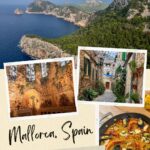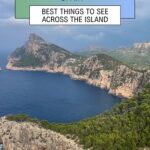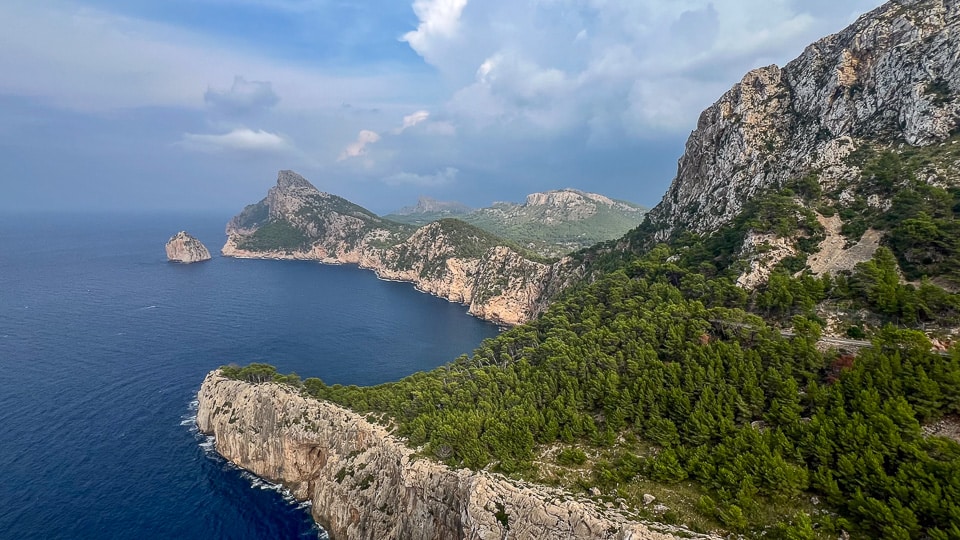
Mallorca, Spain, is so popular it’s been almost embarrassing to confess it was the only one of Spain’s 17 regions we’d not visited – up until now.
Mallorca is the largest of the four populated Balearic Islands, which lie in the Mediterranean Sea east of Valencia, Spain. To the north of Mallorca is Menorca, a small, green wind-swept version that is one-fifth the size and one-tenth the population of Mallorca. Ibiza and tiny Formentera are situated farther south. Ibiza shares Mallorca’s population density and tourism numbers, while the fringe islands of Formentera and Menorca are their calmer, quieter sisters. Together these make up Spain's Balearic Islands, a distinct autonomous region of Spain.
The Baleares are simultaneously part of Spain and distinct from it. They mirror Spain's culture, but with dramatic twists. The unique dialect of Mallorquin takes off from the Catalan language. The Baleares are not volcanic (like Spain’s Canary Islands in the Atlantic), but created by uplifts of peaks and dune hills from the ocean floor. The landscape is a condensed version of Spain's with similar agricultural products like olives, oranges, and almonds. The climate is Mediterranean, as if Spain’s climate were taken up a few notches. It's more humid than the Peninsula (as locals call mainland Spain) and greener than all but Spain's northern provinces. Little rain, lots of sun. Like mainland Spain, the food is steeped in local culture and necessity. Historic sites are generally well-protected, renovated, and now turned over to modern uses.
Given its compact geography, panoramic views, and plentiful sandy beaches, Mallorca has earned its title as one of the best places in Europe to holiday. The impact of tourism on the islands is as great as anyplace in Spain. But there’s a reason for that and a determination to deal with it. Known for its beaches and nightlife, its equally appealing for its dramatic scenery, cultural heritage, historic mountain villages, and variety of outdoor activities. It has year-round appeal, top-notch food and restaurants, a hundred or so 5-star hotels, 26 golf courses, and lots of sunny days to explore the natural settings both on its coast and in the interior.
Our visit was inspired by new non-stop flights from Newark to Palma de Mallorca. And we needed to bust our impressions of Mallorca being nothing more than a beach destination. We took the opportunity to visit Menorca, too, and know you'll enjoy comparing the two.
Table of Contents
Historic Notes
Probably nobody ever said they are visiting Palma de Mallorca for its historic sites. In a nutshell, the islands’ earliest known inhabitants were hanging out around 2500 BC. In Menorca especially (more on this later), the Talayotic ruins scattered across the exposed coastal land speak to the sophisticated pre-Roman communities and communications from around 1500 BC.
The ancient population was known for their skills with slingshots and they were recruited as mercenaries. (Hence the islands' name, Baleares, to launch.) Over time, the island inlets and bays became a great place for landings by seafaring Romans, Phoenicians, and pirates from all over the place.
Natural harbors attracted maturing naval forces. Vikings, Berbers, Muslim, Christians: just about everyone tried their hand at controlling these islands. But the reconquest of Palma in 1229 by James I of Aragon led, eventually, to the period under the reign of Ferdinand and Isabel. The King and Queen combined the then separate island states, delivering the whole to Charles V. In a circuitous fashion, they eventually became part of Spain in 1802; the Balearic Islands were designated an autonomous community in 1983.
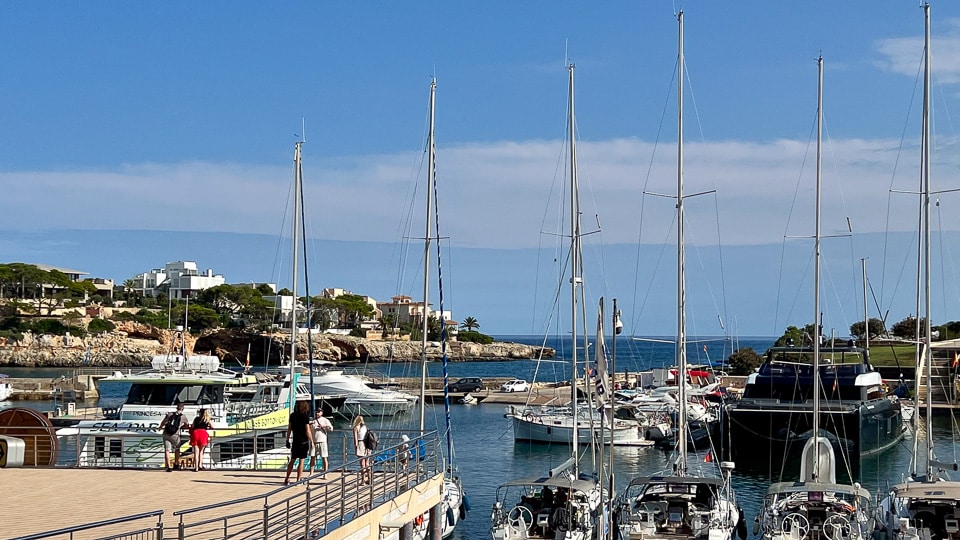
The Story of Tourism in Mallorca
Fast forward to the 20th Century. By the 1960s – post World War II and when working people were beginning to earn vacation time – interest in Mallorca and the Balearic Islands started to blossom. For Mallorca, this meant a fairly drastic change in land use and ownership. Historically, a family’s eldest son inherited the country estates whose wealth was based on agriculture and local industry. Now, mid-century, the second sons were busy developing properties and hotels on the coast to accommodate the new business of tourism.
In fact, Mallorca could be considered the birthplace of Spain’s tourism. Many of the world’s major hotel companies were founded here, like Barceló, Meliá, and Iberostar, and some are still headquartered in Palma.
According to Skift, Mallorca recorded 8.5 million room nights in August this year, more than any other autonomous region of Spain. So it’s not surprising that Mallorca was the site of overtourism protests this year. But Skift also reports that only 11% of Americans are aware of the overtourism protests, and even fewer care. Up to now, most visitors to Mallorca have been European, mostly Spaniards, Germans, Brits, French, and Scandinavians.
Attention has turned to the North American market because our interests apparently align with those very things Mallorca wants to promote. “American tourists have a strong interest in nature, local cuisine, responsible travel, and exploring small towns. It’s a market that is very committed to sustainability and seeks out the things we want to promote,” said Susanna Sciacovelli, Director of the Mallorca Tourism Board.
Dealing with overtourism is top-of-mind for officials in Mallorca. Read on and you’ll discover some of the solutions. The message is clear in the Mallorca Pledge: consider off-season travel, consider out-of-the way destinations, travel with respect for the local economy.
You can listen to Kris's reports on Menorca and Mallorca by visiting her Travel Writers Radio Soundcloud page. For more details on Menorca, the smaller, quieter island, read the Travel Past 50 guide to visiting the island of Menorca.
Places to Visit in Palma
The city of Palma is the capital and largest city of Mallorca and the Baleares. (The island's population is 962,000 and Palma accounts for 419,000 of that.) Palma de Mallorca refers to the region of the island, one of six. We spent little more than a day in Palma due to our interest in exploring less traveled parts. But while our guide to Palma is brief, we were impressed with the options.
Palma's port and the Playa de Palma take up most of the waterfront lens. If you want to explore the old town and find both historic architecture and modern urban advantages – like shopping, fine food, and events – Palma’s the place.
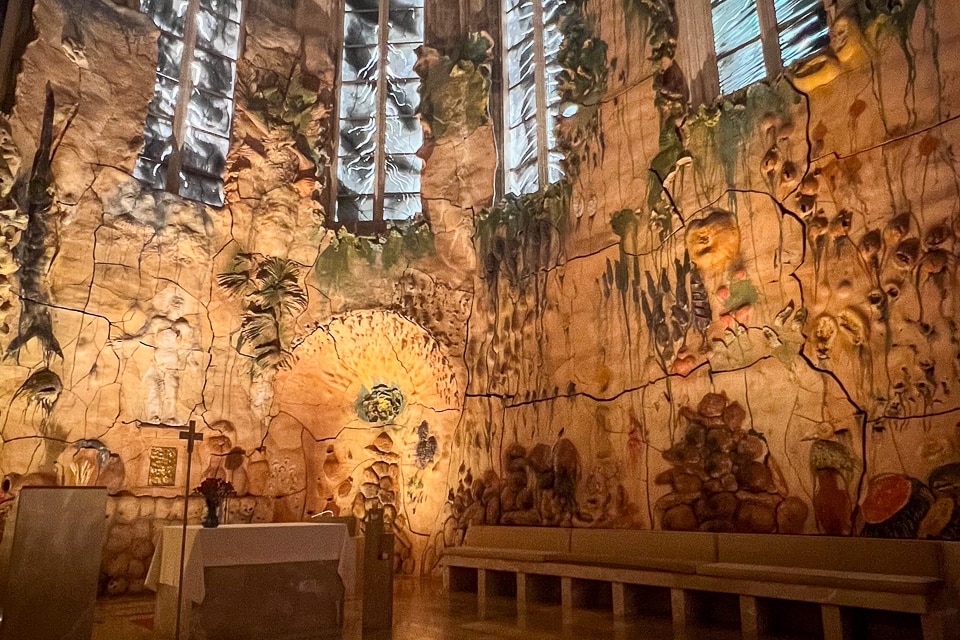
La Seu
La Seu, the cathedral of Palma, was built on a previous mosque which was built upon a Christian church. Construction of the Gothic cathedral began in 1229 and continued to 1601. So you can identify architectural styles and renovations from 13th century right up to the present. La Seu is the tallest church in Spain, and the 3rd tallest in the world. It’s generally known for its huge rosette window and the fact that twice a year (Feb 2 and Nov 11) the light through the window completes a full image on the opposite wall, below another, smaller rosette window.
Catalan architect Anton Gaudí participated in a restoration of the church in 1901, and contributed an impressive baldachin, or canopy, above the altar, as well as improvements to sound and sight lines. Bringing the church into the 21 Century, Spanish artist Miguel Barcelo’s ceramic installation in a chapel of la Seu depicts the miracle of multiplying loaves and fishes. Somehow each century's contribution brings the whole architectural vernacular back to earth.
Tours up the 300 steps to the rooftop are well worth it, to have a look at the buttresses, the rosette window from outside, the broad port and city views, and the information provided about newer stained-glass windows installed in the 20th Century.
See more photos and read about all the top cathedrals in Spain in our popular post.
In the Cathedral Area
Next door to La Seu cathedral is the Royal Palace of la Almudaina, complete with gardens and views of the port. The Palace, a Patrimonio Nacional site, dates to the 14th Century, and is still an official residence of the King and Queen when they are in Mallorca. Open for ticketed visits.
Nearby is the lovely gothic La Llotja, the old mercantile exchange, now exhibition hall.
A walking tour around the cathedral area will take you past the Parliament building, various mansions, and narrow streets dating to Moorish times. This is also a lively neighborhood for great restaurants.
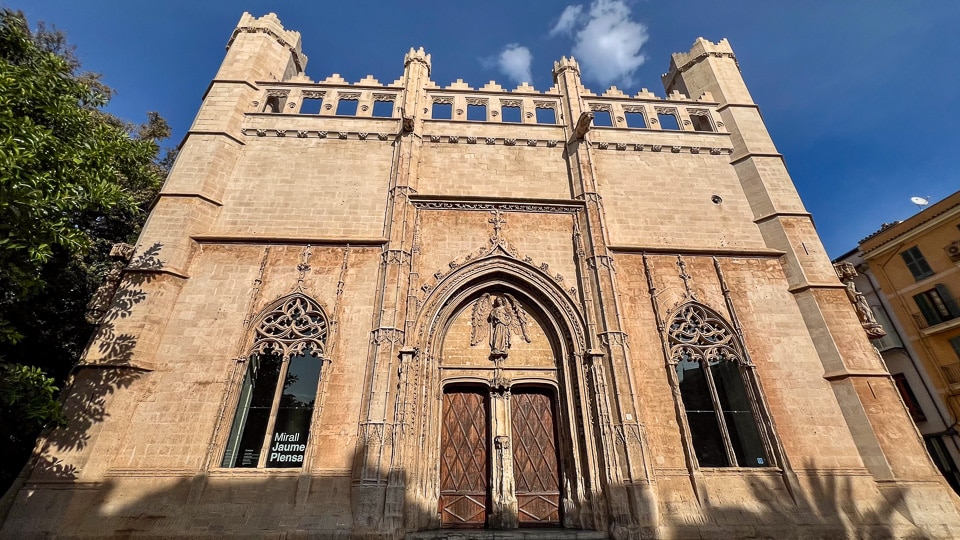
Museums and More
With a few days in Palma, you'll also want to visit the Baluard Modern and Contemporary Art Museum and the Arab Baths. Dating to the 11th Century, the well preserved Arab baths are located in the gardens of Can Fontirroig right in city center. The Museum of Mallorca provides a comprehensive history of the region through archeology and art.
Based in Barcelona, Fundació Pilar i Joan Miró Mallorca, opened a second location in Palma, giving a nod to Miró's connection with the island. It includes exhibit space with Miró's work, special exhibits, and education programming.
Find more information about these and other museums in Palma here.
Places to Visit Across Mallorca
Serra de Tramuntana
The Tramuntana mountains run along the west coast of Mallorca, defining another of Mallorca's six regions. The range was declared a UNESCO World Heritage Site in 2011 for its “great physical and cultural significance.” The natural beauty is described by spectacular rocky cliffs falling into the sea, by idyllic small coves created by the ‘torrents’ of water that wash down ravines (there are no rivers in Mallorca), and by the picturesque drives. Think of a winding road through pine trees to look-outs over turquoise waters.
The cited ‘cultural significance' might be a little harder to discover. Specifically, it recognizes Mallorca's ancient system of terraces, rocky walls, and water management, all providing for successful agriculture even in the rocky Tramuntana montains. At the same time, UNESCO includes the villages, churches, towers and lighthouses representing Mallorca’s history and culture.
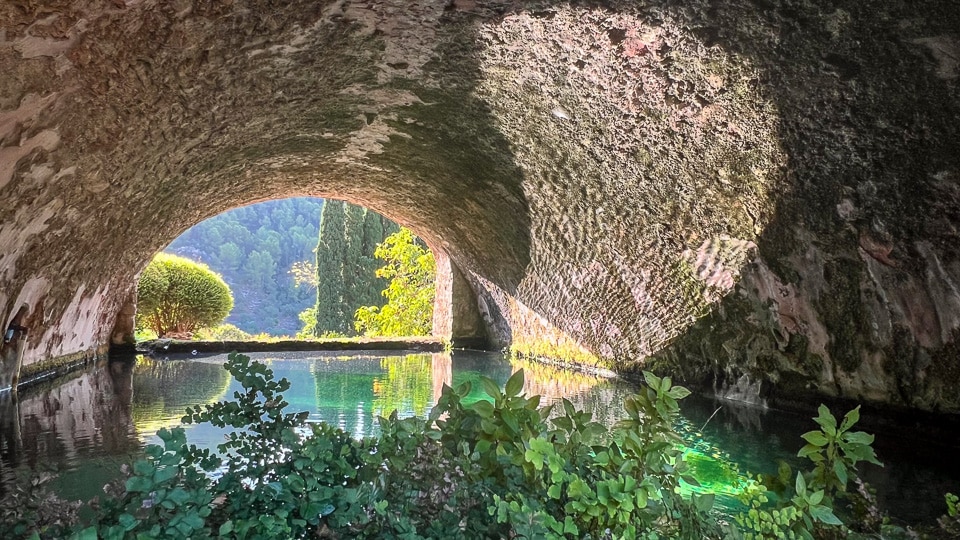
Gardens of Alfabia
Start with the amazing Gardens of Alfabia, just into the foot hills of Serra de Tramuntana (and under 30 minutes by car from Palma). This property combines lush gardens demonstrating Moorish influence, and the estate home still held by the same family over many centuries.
Cristina Zaforteza Fortuny, today’s representative of that lineage, described the whole as “a house with a history; a garden with charm.” The gardens’ water features will recall the Alhambra; the total effect is more calm, green and intimate. Touring the home, you’ll see a 13th Century Moorish ceiling at the entry gate, a 15th Century chair, and documents related to the family and property heritage. Originals of some items are shared with the Museum of Mallorca.
Hers is only one of a handful of the 1,200 fincas (country estates) that’s remained in the same family all these years. The family business is now intrinsically related to tourism, offering a retreat from the city and coastal areas, and a stunning property for special events.
Mountain Villages
Get a real sense of Mallorca, apart from the coast, at various historic towns tucked into the mountains.
Sóller is easily reached from Palma – or from the Alfabia Gardens – by train or by road. The Soller Train from Palma, established in 1915, was the only tunneled route between the two points for decades. A vintage tram continues from Sóller to Port de Sóller about 3 kilometers away.
Sóller’s train station features a Picasso exhibition of ceramics (closed when we passed through on a Sunday, but free admission when it’s open). Another exhibition room displays work by Joan Miró, who spent summers here with his wife’s family.
The old town of narrow, relaxed pedestrian streets, is dotted with mansions, evidence of the area’s successful orange and olive production. Shopping is along Carrer de sa Luna (get it? sun and moon?). The town’s botanic gardens and surrounding valleys draw bicyclists and outdoor enthusiasts.
From Sóller, continue to Deià, a tiny village know better these days for its surrounding luxury properties. From the literary name-dropping (Robert Graves and Anaïs Nin both set stories in the area) to contemporary celebrity sightings, the focus will eventually turn to the 5-star Castilla Hotel Son Vida Residencia. If nothing else, visit for a lunch at the Restaurant Miró to enjoy gazing upon the dozens of Miró prints on the lobby walls, a look at the Son Vida neighborhoods on opposite hills, and for excellent fare and top notch service. This might be the Mallorca area with the highest concentration of famous homeowners, including Richard Branson. Princess Diana reportedly had a paid purchase agreement here when she died.
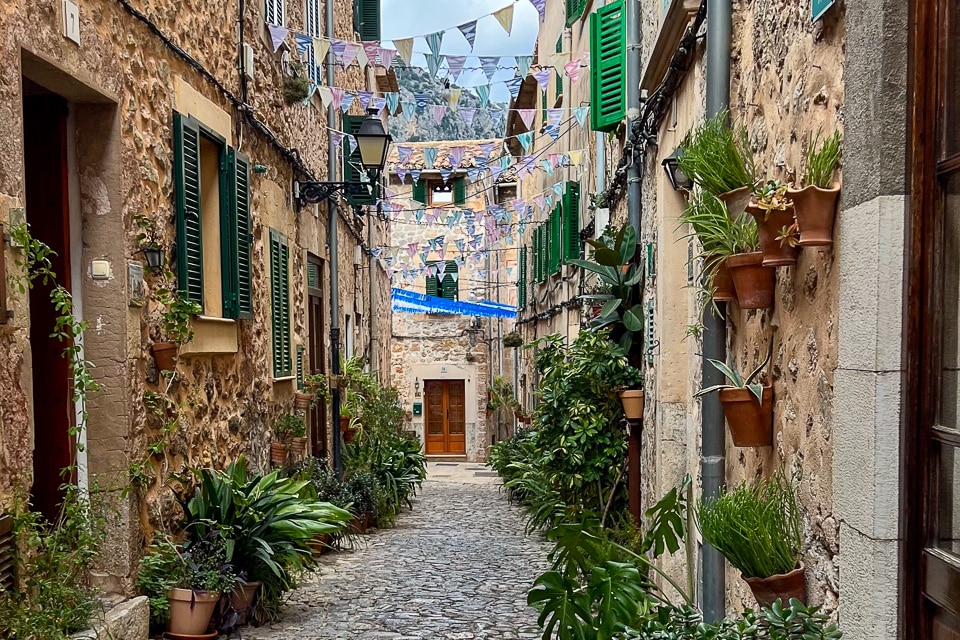
Valldemossa is just a bit further south. The old town is fun to stroll through. You are bound to wind up at a stature of Chopin, where you’ll learn that he and French writer George Sand retreated here in the late 1830s. Besides the small Chopin museum, a 13th Century monastery is a top visitor attraction, and the 17th Century mansions of the successful land class are still impressive. Driving near Valldemossa, a popular game could be guessing over which cliff the home of Michael Douglas and Catherine Zeta-Jones might be nestled.
In all cases, these mountain villages exhibit great pride in their history and hospitality. Check local calendars for festivals that draw Mallorcans and international visitors alike.
Dragon Caves
On the opposite coast from the Tramuntana range, the Drach Coves (Dragon Caves) near Porto Cristo are one of Mallorca's most popular tourist attractions. The tours last about an hour, tracing a route through tunnels and underground rooms filled with stalactites and stalagmites. There are several lakes in the caves and guests can opt to cross Lake Martel by boat or footbridge.
Rafa Nadal Academy and Museum
In Manacor, Mallorca, just a short drive from Porto Cristo where Rafa Nadal makes his home, is the impressive Rafa Nadal Academy and Museum. Check it out. It'd be especially fun for kids and anyone who wants to test their skills with interactive exhibits. Or browse the museum exhibits, find the retail store, and look around the grounds. With 23 hard courts and 20 clay courts and a wealth of other facilities, the Nadal Academy plays host to camps, tournaments, and an immersive international school.
Scenic Viewpoints
The coast of Mallorca is among the most thrilling you’ll see, and the views of the Mediterranean’s blue waters inspiring. Who doesn’t look out and think of the early explorers, sailors, pirates, ancient communities…or contemplate the horizon? Drive carefully: the narrow mountain roads are busy. But these select viewpoints will be worth your trouble.
Porto de Soller. Photogenic example of the tranquil coves around Mallorca and the access by yachts small and large.
Mirador de sa Foradada, Son Marroig. Reach this between Deià and Valldemossa. In addition to the spectacular views, find bar/restaurant services at the viewpoint. Far below, in the rocks at the end of the point, is a diabolically located restaurant, Sa Foradada. Best reached by boat, perhaps, rather than the steep single road down.
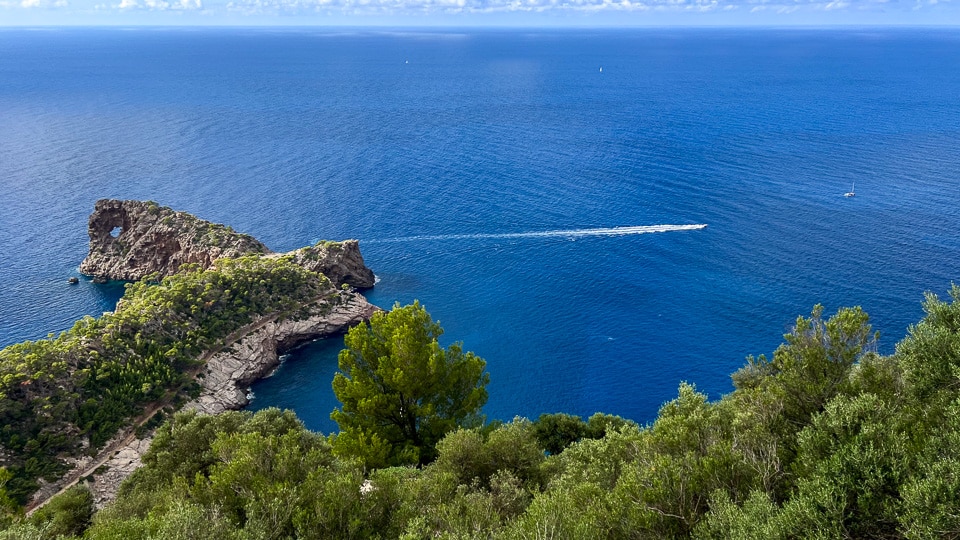
Mirador de Es Colomer is the granddaddy of scenic overlooks on Mallorca. The spectacular cliffs might be a thousand feet or more, diving straight down to the rocky coast below. Walk up from the parking area to look over the sides of a rocky pier and across to the equally spectacular facing cliffs. Note, the approach road is shared by bikes, cars and buses. But if you want to get there, you’ll have to choose your poison. Guard rails at the viewing platform are not up to standard, so keep children in hand. And please don’t feed the deer. Other than that, forget all this and just hang out for the view for as long as you wish. No pictures will do it justice.
We skipped a visit to the Caves (see below) to visit the Sanctuary of San Salvador, a former monastery. Today it is primarily another viewpoint and destination for ambitious cyclists. Check that box!
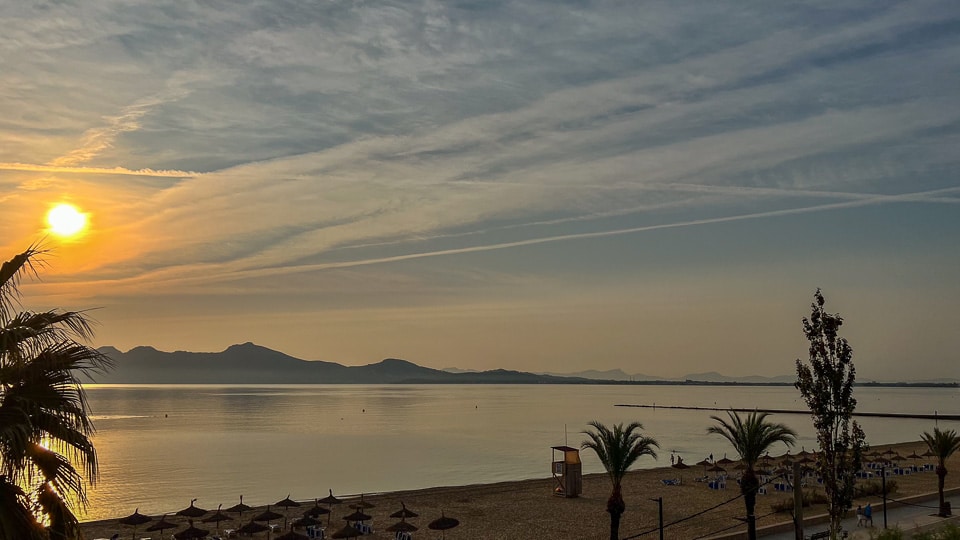
Pollensa and Puerto de Pollensa
Pollensa, a town of 12,000, combined with the Port of Pollensa on a wide, sandy bay nearby, bring together the best of Mallorca in a laid back setting. After the lux experiences on show in the northwestern mountains, the open views of the beach and the normalcy of the small town invite visitors to stay a while and create their own routine.
In Pollensa, the main attraction might be the Calvary Chapel uphill from the town's main square. The 365 Calvari steps from the chapel down to town are the scene for the annual Good Friday pageant. Visit the 16th Century church and adjacent convent converted to an arts and event center. This is a great example of the ways in which modern Mallorca has repurposed historic centers for lively contemporary use.
The peaceful Port of Pollensa community surrounds the beachfront of Pollensa Bay, opening to the Balearic Sea facing northeast toward Menorca. A small port of pleasure and fishing boats provides some action along the beach walk, and you’ll find all sorts of hotel options (see below) and restaurants. The joy of this place comes from the colors at sunrise, walking the beach in the morning, or lounging any time of day to watch others. Popular activities include biking, open water swimming, water sports, and sunning.
Four Seasons Resort Formentor
From the shore at Port of Pollensa it’s easy to see “The Line,” the long, low white line of a hotel. That’s the new Four Seasons Resort Mallorca at Formentor. It reopened in 2024 after major renovation of the historic hotel originally built there in 1929. Like the Son Vida Residencia, this 5-star property is worthy of a visit for lunch, at least, if you aren’t staying there, to catch the scene.
Beaches
On Mallorca, you can find both the ”long beaches” and a series of cozy coves and smaller beaches. Playa de Palma, naturally, is one of the most famous long beaches. For a guide to Mallorca’s best beaches, we recommend the local paper’s list published in October 2024. Mallorca tourism, too, helps you find the right beach for your day. For our part, we could have stayed another week in the Pollensa beach area, with its broad sand (enhanced by dragging sand up from the sea), protective bay, and access to historic Alcudia and Pollensa towns nearby. We’re also partial to Can Picafort, with beaches adjacent to the port, site of our great water sport adventure with Salty Cycling.
Outdoor Sports and Adventure
Water sports
No better place to start than with Salty Cycling. Check out this newest of water sports: aquatic cycles with electronic assist. Imagine a foil board and e-bike combined. Can’t imagine it? Watch this video.
The knowledgeable crew at Salty Cycling in Mallorca excel in offering training and mini tours aboard your Salty Cycling bike. They are only one of 10 distributors of the Hydrofoiler Manta5 products. But their real claim to fame was attempting to train five of us over-50 travel writers to master the aqua ebikes – in an hour.
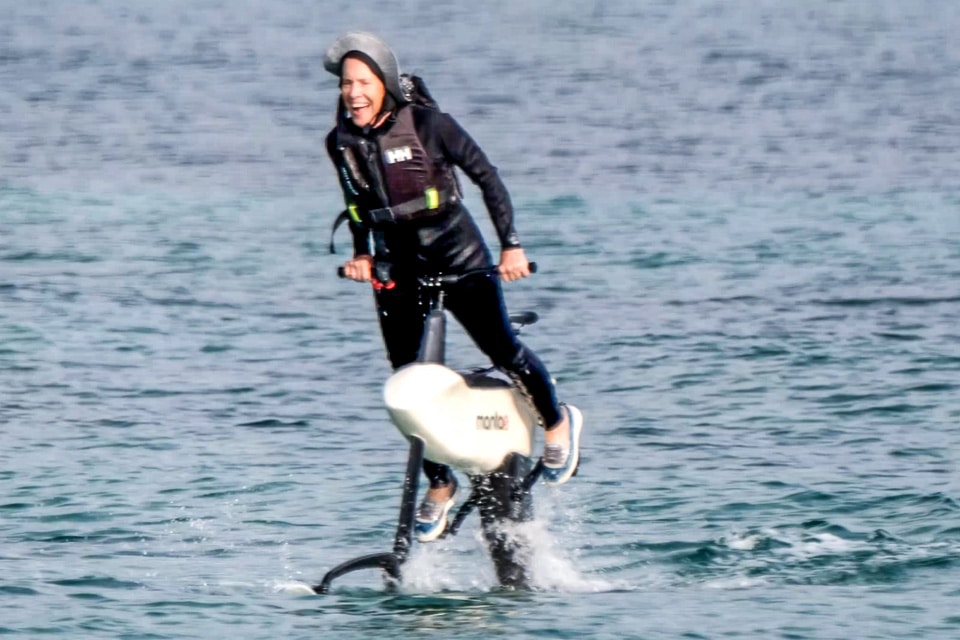
OK, it wasn’t quite as easy as it looks, but I managed to get the bike up out of the water for a short ride. Now I’m dying to try again so I can progress to the sitting down and pedaling part! Be sure to schedule time with Salty Cycling at Can Picafort to try this new sport.
Mallorca hosts sailing events and is a great location for snorkeling, diving, open water swimming, and all sorts of motorized and non-motorized watercraft.
Golf
There are two dozen golf courses on the island of Mallorca. Son Vida Golf, the oldest course on Mallorca, opened in 1964. It’s now one of four courses at the Arabella Golf Resort of Mallorca.
Additions and improvements continue across the island, appealing to pros, amateurs, and beginners. Case in point, I played nine holes at one of the Arabella Golf Club courses, not at all intimidated by photos of Tiger Woods and a recent Solheim winner playing these very links. Thanks to the friendly and helpful people at Arabella Golf for encouragement!
Hiking & Cycling
According to Mallorca tourism, some 35,000 cyclists visit Mallorca each year to enjoy the scenery, to train for competitions, or to add some adventure to their Mallorca holiday.
Cycle tourism is another path by which tourism is spreading out away from the coast lines. Over 1,250 miles (2,000 km) of local roads and paths take on cyclists year round. A guide to various routes can be customized from the Mallorca tourism website. 120 hotels specialize in cycling, offering rentals, repairs, adapted menus, and tour support.
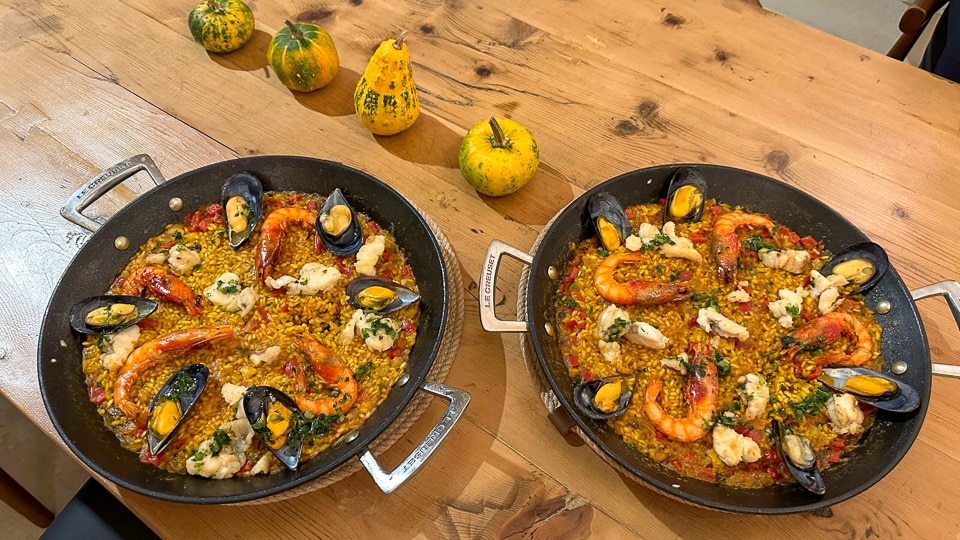
Food and Restaurants
During our short visit, under a week, we couldn’t begin to sample all of the best restaurants of Mallorca. Given the number of 5-star hotels on the island (around 100!), demand for excellent quality restaurants is also high. Let our select experiences with food and restaurants be your guide.
Across the island, menus and markets are driven by fresh fish and fresh produce. To learn more about Mallorca’s specialties we highly recommend you start with these experiences.
Moltak Windmill Kitchen. Sign up for a spot or two with a small group, or reserve your own group gathering at Moltak Kitchen in a Palma windmill. You’ll learn lots about local fare and about cooking these fresh ingredients to prepare some classic Spanish dishes. Best of all, the experience is fun and familiar, like being in the kitchen with family (only better) as you get to know each other and work as a team. The evening ends by gathering around the table and sharing the dinner you've prepared. It will be every bit as good as a restaurant meal, and you'll be able to take home the recipes, photos, and good memories.
Aubocassa olive oil tasting. Aubocassa presents an exceptionally informative overview of olive growing and pressing. With the enthusiasm of a start-up, Aubocassa explains traditional olive oil making and shows visitors how they’ve stepped up the quality with their quick tree-to-oil cold press process. Factoids: green and black olives are from the same tree, not different varieties. It’s time to harvest when all three colors – green, dark pink, and black – appear on the tree. And taste? We learned with our noses and our tongues that the most delicate olive oils offer a fresh grassy perfume, but very little taste.
Aubocassa offers wine tasting, too. The Roda bodega wines are based on La Rioja vines, and Bodegas La Horra (Corimbo) from Ribera Del Duero.
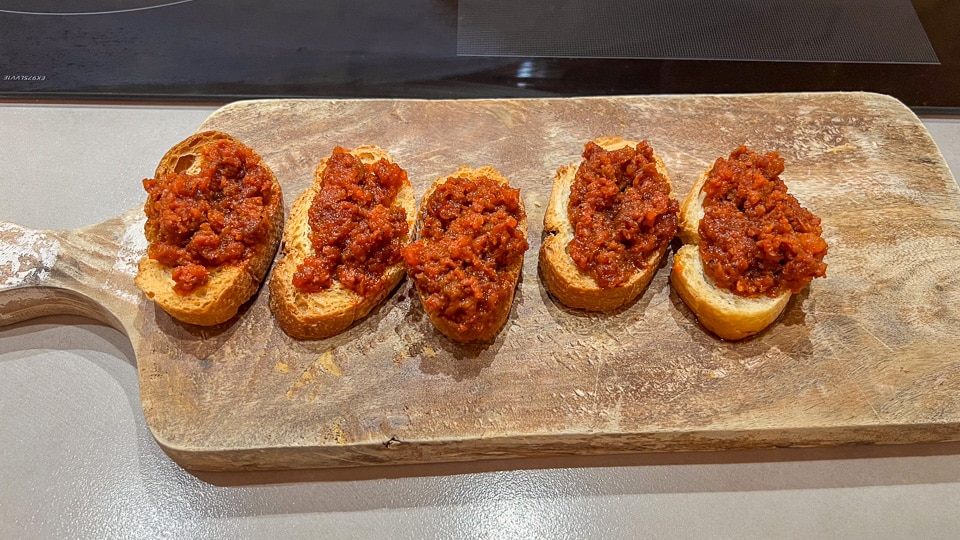
Keep an eye out for these local dishes:
Sobrasada, a spicy pork sausage popular here in part because the humid climate doesn’t lend itself as well to jamon serrano. Heat a bit of sobrasada with honey and vinegar to make a delicious appetizer spread.
Sopas, a stew like concoction made with vegetables on hand, and dotted with croutons. The story goes that every country home used up its produce in this dish, and was sure to share a portion with those neighbors in need.
Pa amb Oli, bread smeared with olive oil and tomatoes and salt, and variously topped with cheeses or cold cuts.
Ensaimada, a lovely pastry for any time of day, I say. In Palma, visit Fornet de la Soca to sample the best of the best.
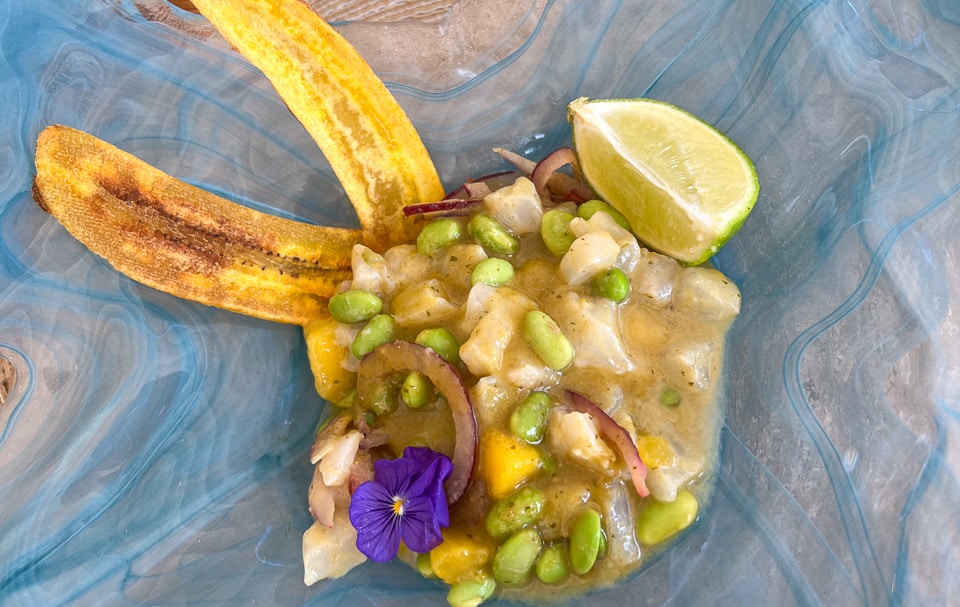
Outstanding Restaurants
Moltak Windmill Kitchen. Palma. For cooking classes and great dining. See above.
Restaurante Caballito de Mar. Palma.
Son Vida Restaurant. At Arabella Golf Club and Resort, Palma.
Restaurante Miró.At Belmond Hotel La Residencia, Son Vida, Deià.
Mesón C'an Pedro en Génova, a big and busy classic Mallorcan/Spanish restaurant featuring grilled meats and fresh fish. Snails! Palma.
Faro Gastropub. Perhaps my favorite meal, with ceviche, octopus, and freshest of salads in an unassuming setting along the docks. Porto Cristo.
La Terrassa. Serving the local sopas dish mentioned above. In Hotel Illa d'Or, Puerto Pollensa.
Mel. The indoor/outdoor restaurant named for honey and open all day. Located in the Four Seasons Hotel Formentor, Playa de Formentor, Puerto Pollensa.
U Nautic. Situated right on the port pier, Puerto Pollensa.
Sandro 10. Across from our HM Palm Blanca Hotel. This Italian bistro has attracted a flurry of interest because Morgan Freeman claimed the pasta Bolognese was the best he’d ever had. It's really good, and the tomato salad as beautiful as it was fresh. I enjoyed the peppery cacio e pepe. Palma.
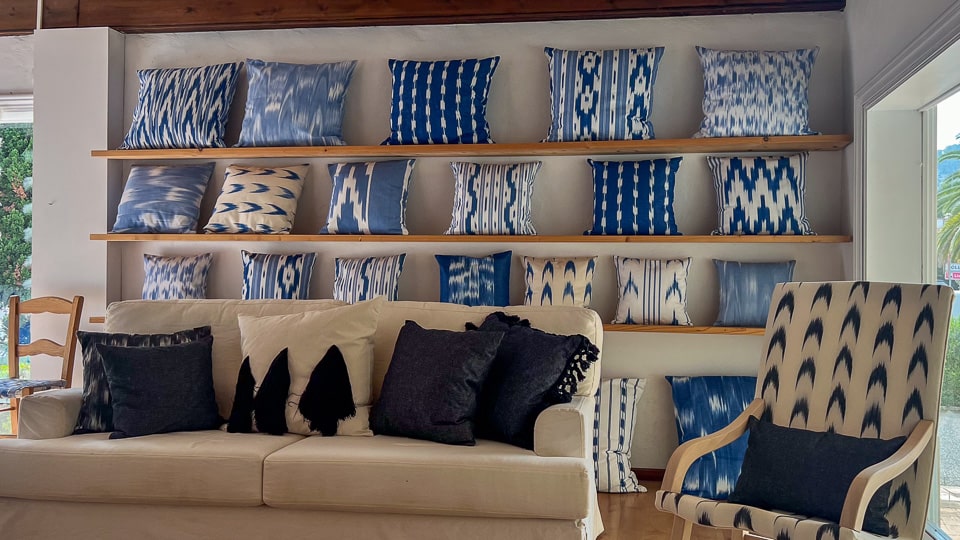
Shopping
Historically, the Balearic Islands have designed and produced shoes and jewelry for all of Spain and beyond. Now many of their shoe brands are sold worldwide, like Menorquinas sandals from Menorca, Carmina shoes (the oldest brand from Mallorca), Tony Mora boots, and the foundation of the current Camper brand footwear.
Mallorca has been a major producer of costume jewelry for a nearly a century, and some “Majorica” brand jewelry has now achieved collector status. Cultured pearls and pearl jewelry is still a mainstay of the industry. Take a self-guided shopping trip with the help of Mallorca's travel information site.
Aubocassa Olive Oil. Go take the tour at Aubocassa (see food notes above) and purchase your olive oil there. Or, look for it in local shops or online at Despana Brand Foods.
Textiles from Vicens. Generations-old weavers whose designs, dyes, and weaves are outstanding examples of the trade.
Festivals
Other than national holidays and the Holy Week processions found across Spain including Mallorca, many local festivals celebrate Mallorca’s heritage, agricultural products, and its forward-looking arts and style. Look for monthly calendars of events and you’ll see everything from yoga to grape or olive festivals, from a major film festival in October to the very unique Moor and Christian battle reenactment every year in May.
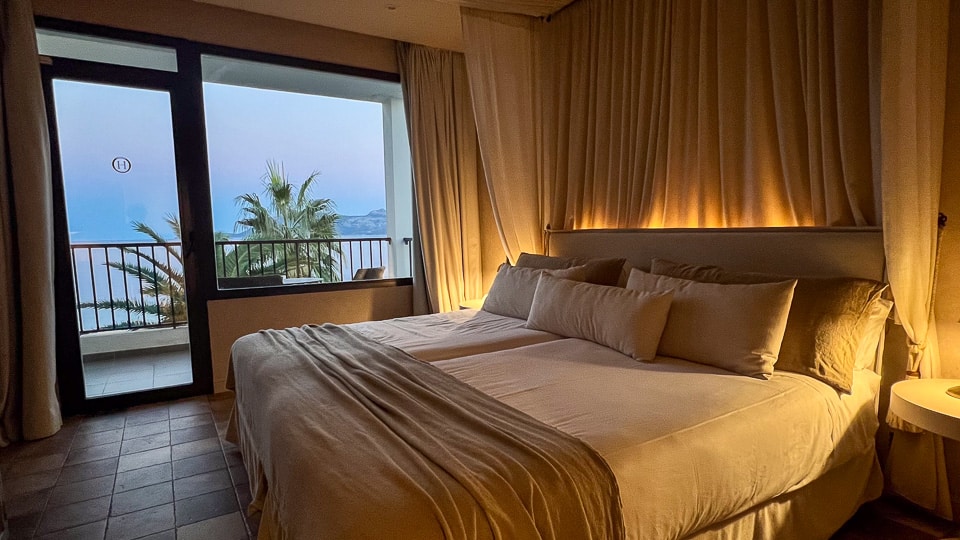
Getting There and Getting Around
Good news for North Americans, it’s now easier to fly direct to Palma de Mallorca. United is offering direct flights from Newark, and promises to add others next season.
Travelers coming in with cars will want to catch a ferry from Barcelona or Valencia. Without a car, it’s easier to connect by air to the Beleares and then rent a car at the airport. If you’re not interested in hiring a car to get around, bus lines will get you across the island, and taxis will finish the distance.
Hotels
While Mallorca tourism touts its huge number of 5-star hotels, be aware that the inventory is varied and prices fluctuate from high season to shoulder and winter rates. On the higher end, we've already mentioned the classy Four Seasons and the Son Vida Residencia above. In addition to hotels, Mallorca offers thousands of villas for rent, perfect for families or longer stays.
Castillo Son Vida Residencia, Palma de Mallorca region.
Four Seasons Mallorca Formentor
Here's where we stayed in Palma and Pollensa:
HM Palma Blanc, Palma. A sleek, modern hotel in a good location for walking the old town. Rooms are compact.
Hoposa Hotel Uyal, Puerto Pollensa. Ample rooms with balconies overlooking the beach and Balearic Sea.
Hotel Illa d'Or, Puerto Pollensa. With views of the port, Pollensa Bay, and mountains. This hotel is made famous by Agatha Christie, who first visit in 1932. She stayed at Illa d'Or and later cast it in her 1935 book, “Problem at Pollensa Bay.” (“Evil Under the Sun” was set in nearby Formentor.)
Son Sant Jordi Hotel, Pollensa. Though we didn't stay here, we visited this family run boutique hotel, open year round. It's a prime example of inland, rural tourism options in Mallorca.
Best time to travel to Mallorca
Yes, Mallorca is a popular and growing tourist destination. So keep that in mind and avoid high season and August especially, when Europeans vacation. It's recommended you keep to the shoulder seasons of Spring and Fall. Even winter is appealing with average low/high temps at 45/60 degrees Fahrenheit. Summer lows might be around 70 with highs in the mid to upper 80s and higher. Mallorca is more humid than the peninsula, so the ‘feels like” temps may differ. The rainiest months of October and November may still only produce a couple inches a month.
Anytime is a good time to visit Mallorca if you can explore beyond the beaches to all it has to offer.
Up Your Travel Skills
Looking to book your next trip? Use these resources that are tried and tested by us. First, to get our best travel tips, sign up for our email newsletter. Then, be sure to start your reading with our Resources Page where we highlight all the great travel companies and products that we trust. Travel Accessories: Check out our list of all the accessories we carry to make getting there and being there a lot easier. Credit Cards: See our detailed post on how to choose the right travel rewards credit card for you. Flights: Start finding the very best flight deals by subscribing to Thrifty Traveler. Book your Hotel: Find the best prices on hotels with Booking.com. See all of the gear and books we like in one place on our Amazon shop.Got a comment on this post? Join the conversation on Facebook, Instagram, or Threads and share your thoughts!

